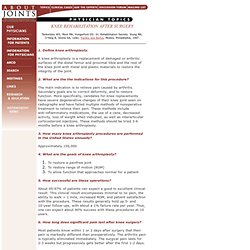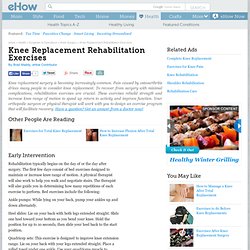

TOTAL KNEE COMPLICATIONS. Patellar Clunk Syndrome: Complication Following Knee Replacement Surgery : TotalKneeWeb.com – Simple, Concise Information on Total Knee Replacement & Related Topics. Home » Patellar Clunk Syndrome: Complication Following Knee Replacement Surgery In general, Total Knee Replacement (TKR) is a highly successful procedure.

In fact, according to the American Academy of Orthopaedic Surgeons, more than 90% of patients have well functioning implants 15 years after surgery.1 Unfortunately, complications, although relatively rare, can sometimes occur. One such complication is known as Patellar Clunk Syndrome. Patellar clunk syndrome can result in the following symptoms: “Patello-femoral” knee pain (pain in front of knee in region of knee-cap)Knee “popping” or catching during bending and straightening as in rising from a chair To understand this condition, it helps to first understand a little bit about normal knee anatomy and function (Figure 1). Figure 1: Basic Knee Anatomy During knee flexion (bending) and extension (straightening), the patella (knee-cap) rides within a “track” or groove in the femur (thigh bone), known simply as the patellar groove.
PRE-OPERATIVE PHYSICAL THERAPY .pdf. Total Knee Replacement Exercise Guide - Your Orthopaedic Connection. Copyright 2011 American Academy of Orthopaedic Surgeons Total Knee Replacement Exercise Guide This article is also available in Spanish: Ejercicio después de reemplazo de rodillaEjercicio después de reemplazo de rodilla (topic.cfm?

Topic=A00494). Regular exercise to restore your knee mobility and strength and a gradual return to everyday activities are important for your full recovery. Your orthopaedic surgeon and physical therapist may recommend that you exercise approximately 20 to 30 minutes two or three times a day and walk 30 minutes, two or three times a day during your early recovery. Your orthopaedic surgeon may suggest some of the following exercises.
Start the following exercises as soon as you are able. Quadriceps Sets Tighten your thigh muscle. Repeat this exercise approximately 10 times during a two minute period, rest one minute and repeat. Straight Leg Raises Tighten the thigh muscle with your knee fully straightened on the bed, as with the Quad set. Ankle Pumps. Knee Rehabilitation After Surgery. Tankersley WS, Mont MA, Hungerford DS: In: Rehabilitation Secrets.

Young MA, O'Yang B, Steins SA, (eds). Hanley and Belfus, Mosley, Philadelphia, 1997. 1. Define knee arthroplasty. A knee arthroplasty is a replacement of damaged or arthritic surfaces of the distal femur and proximal tibia and the rest of the knee joint with metal and plastic materials to restore the integrity of the joint. 2. The main indication is to relieve pain caused by arthritis. Knee Replacement Rehab - Knee Replacement Recovery. Day of Surgery: The day of knee replacement surgery is mostly a day to recover from your procedure.

But it is not just about rest. Depending on the time of day of your surgery, you may be asked to sit in a chair or on the side of the bed. Patients will begin simple activities including ankle pumps, leg lifts, and heel slides. It is important for patients to take sufficient pain medication to allow them to participate in their rehabilitation exercises. Some doctors will place you into a motion machine, called a CPM. Hospitalization: During your hospitalization, you will meet with physical and occupational therapists.
Therapy progresses at a different pace for each patient. Discharge/Rehabilitation: Patients are usually discharged 3 to 5 days after knee replacement surgery. If patients are not progressing to the point that they can safely return to their home environment, in-patient rehabilitation may be recommended. Patients who return home will have home services arranged as necessary. Knee replacement surgery. Joint replacement involves surgery to replace the ends of bones in a damaged joint.

This surgery creates new joint surfaces. In knee replacement surgery, the ends of the damaged thigh and lower leg (shin) bones and usually the kneecap are capped with artificial surfaces lined with metal and plastic. Usually, doctors replace the entire surface at the ends of the thigh and lower leg bones. Doctors usually secure knee joint components to the bones with cement. Recommended Related to Osteoarthritis Osteoarthritis: 10 Tips for Self-Care at Home Here are simple ways you can ease osteoarthritis symptoms on your own, at home. 1. Read the Osteoarthritis: 10 Tips for Self-Care at Home article > > Doctors are working on ways to replace just the damaged parts of the knee joint. In knee replacement surgery , doctors remove the damaged cartilage and replace it with new joint surfaces in a step-by-step process.
Doctors often use general anesthesia for joint replacement surgeries. Continue reading below... How to Rehab a Total Knee Replacement. Rehabilitation typically begins on the day of or the day after surgery.

The first few days consist of bed exercises designed to maintain or increase knee range of motion. A physical therapist will also work to help you walk and negotiate stairs. The therapist will also guide you in determining how many repetitions of each exercise to perform. Bed exercises include the following: Ankle pumps: While lying on your back, pump your ankles up and down alternately. Videos - how to rehab a total knee replacement. How to Rehab a Total Knee Replacement. How to Get Extension Back Into the Knee After a Total Knee Replacement.